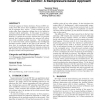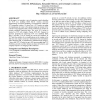802 search results - page 95 / 161 » Sink-to-sensors congestion control |
Publication
The main goals of a switch scheme are high utilization, low queuing delay and fairness. To achieve high utilization the switch scheme can maintain non-zero (small) queues in steady...
SIGCOMM
2010
ACM
13 years 10 months ago
2010
ACM
Overload happens in Session Initiation Protocol (SIP) networks when SIP servers have insufficient resources to handle all messages they receive. Under overload, SIP networks suffe...
MOBIHOC
2005
ACM
14 years 9 months ago
2005
ACM
In this paper, we introduce a novel congestion control algorithm for TCP over multihop IEEE 802.11 wireless networks implementing rate-based scheduling of transmissions within the...
INFOCOM
2010
IEEE
13 years 8 months ago
2010
IEEE
— In wireless networks, TCP performs unsatisfactorily since packet reordering and random losses may be falsely interpreted as congestive losses. This causes TCP to trigger fast r...
INFOCOM
2000
IEEE
14 years 2 months ago
2000
IEEE
— End-to-end congestion control mechanisms such as those in TCP are not enough to prevent congestion collapse in the Internet (for starters, not all applications might be willing...


